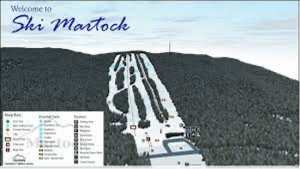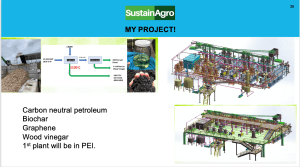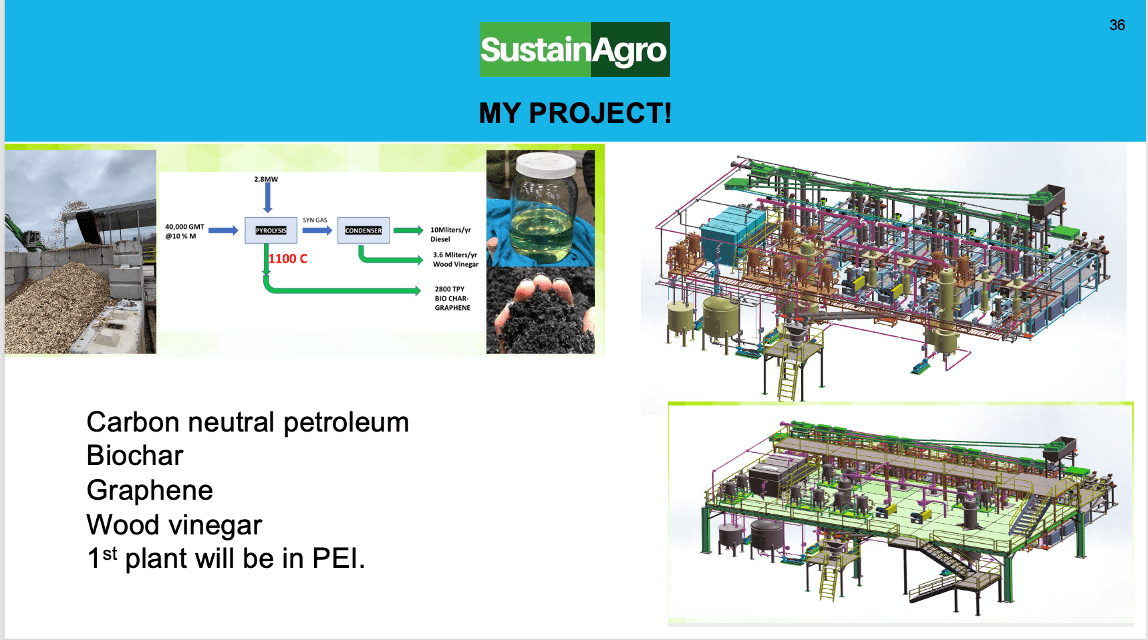By Joey O’Brien, ESRAG Director
Harvard philosopher Roberto Mangabeira Unger wrote, “at every level the greatest obstacle to transforming the world is we lack the clarity and imagination to conceive that it could be different.”
Imagine if all the fears imbedded in the 6th IPCC report come true.
Imagine if winter did not come. I have lived this.
I grew up with my father building community ski resorts in Nova Scotia, Canada. I bought a resort called Ski Martock from him in 1979. Ski Martock is a mid-sized community ski resort with the base elevation only 30 feet above sea level. We employed 278 staff, had over 100,000 annual customers and an average winter season of 109 days. Despite our size we generated several Olympians and had a very strong clientele base.
 As part of good operational practices, I installed a weather station in the summer of 1980, with equipment to measure rain, snow, humidity, cloud cover and depth of snow on the ground. The coldest 800 hours of the season (mean snow-making temperatures) determined the success of our man-made snow production, and therefore our ski season. During the 1980/81 season our mean snow-making temperature was -6.8C. By the year 2000, it was up to -2.3C. That means that for 50% of our snowmaking hours we were running the plant at temps warmer than -2.3C. This is very energy-intensive and inefficient. At peak, we were consuming 2 megawatts of power.
As part of good operational practices, I installed a weather station in the summer of 1980, with equipment to measure rain, snow, humidity, cloud cover and depth of snow on the ground. The coldest 800 hours of the season (mean snow-making temperatures) determined the success of our man-made snow production, and therefore our ski season. During the 1980/81 season our mean snow-making temperature was -6.8C. By the year 2000, it was up to -2.3C. That means that for 50% of our snowmaking hours we were running the plant at temps warmer than -2.3C. This is very energy-intensive and inefficient. At peak, we were consuming 2 megawatts of power.
I sold the resort in 2003. Luckily it was before the warming temperatures had an effect on the fiscal performance. It was a good time to exit.
By 2020, it had zero temperatures below freezing by Christmas, one night below freezing by New Year’s, and so on. Winter 2022-23 was like this too. The operating season had dropped from 109 days to 60-70. Last summer, when I took my granddaughters fishing on the coast of Nova Scotia, I was shocked that we saw barely any mackerel, which had been abundant all my life. The waters off Nova Scotia’s Mahone Bay were unbelievably warm by July 1st. I read last month that ocean temperatures off the NS coast hit record-breaking highs, threatening fish populations.
Climate change has already had a huge impact on our family. As we moved from Nova Scotia to Alberta, you can call us climate refugees. To try to secure a future for our grandchildren and young people across the world, I switched careers to immerse myself in climate solutions. I’m writing to share news of breakthroughs that give me hope.

Joey O’Brien and granddaughter Carmen playing with “old man’s beard” lichen from lodgepole pine trees. Photo by Steff O’Brien
One of the downfalls of our dependence on fossil fuels is that it gives a few regions – including the Middle East, Russia, Alberta and Saskatchewan, and regions of the US. – disproportionate influence over world affairs. Imagine if we could have regional generation of low-carbon liquid fuels that meet the standard of “distributed generation.” What would our society look like then?
Imagine if the current energy systems were low-carbon. Imagine if every community produced all the liquid petroleum they needed, and could use the pipelines and infrastructure we already have.
Natural Resources Canada states “Canada cannot accomplish our climate action goals without low-carbon liquid fuels.” There are billions being invested in low-carbon fuel creation worldwide. This is not magic, but simply good engineering. I am part of one enterprise, SustainAgro, accomplishing this.

Products from the SustainAgro pyrolysis plant, Prince Edwards Island.
We are using pyrolysis to produce carbon-neutral diesel. Pyrolysis is the heating of an organic material, such as biomass, in the absence of oxygen. Our process also produces biochar which can be used to restore carbon to depleted soils, wood vinegar as a carbon-neutral fertilizer, and graphene, which has huge potential as a superconductor and in improving the range and life of EV batteries.
If this method of producing low-carbon fuels were as common as the corner gas station, what would be the impact in putting the world’s people on a fairer footing with petro states and energy companies?
Imagine if electrical and thermal energy could be generated 24-7 in a system that was carbon-neutral, dispatchible, low-cost and easy to site in neighborhoods. Launched by oil and gas drillers who said “there must be a better way,” Calgary-based Eavor has demonstrated how to generate local, clean, reliable, baseload electricity.
Most utility-scale geothermal projects do not work because they consume too much of the energy generated to pump hot liquid from 2-4 km below the earth’s surface. Eavor developed a radiator-like design to collect heat deep below the surface, with heat differentials in the closed piping loop pulling the warm liquid to the surface, no pumping required. Brilliant and simple.
Imagine if the world’s energy systems went fully carbon neutral. This is happening. Renewables will cover almost all of global electricity demand growth out to 2025, becoming the world’s top source of electricity within three years, the International Energy Agency’s new figures reveal.
Alberta, where I now live, is the center of Canada’s fossil fuel industry and the largest supplier of petroleum to the US. But the latest AESO report shows 107 solar PV farms under development in our province, totaling 12.7 GW of AC capacity and about $21 billion worth of private, unsubsidized, property-tax-paying, land-rent-paying investment in renewable energy. This includes 48 solar + storage projects. If their development proceeds as planned, then in 2026, we will have 13.8 GW of PV capacity, which will generate some 23% of Alberta’s annual electric energy, and 100% on any sunny hour of any day of the year.
In addition, there are 49 wind farms under development totaling 7 GW of capacity and about $12B in private investment. If their development proceeds as planned, then in 2027, we will have 10.6 GW of wind capacity, which will generate some 40% of Alberta’s annual electric energy, and 80% to 100% on any windy hour of any day of the year.
This is a total of 60% of Alberta’s annual electric energy generated by solar and wind by 2027, twice the government’s current goal of 30% by 2030. All thanks to the combination of Alberta’s fantastic solar and wind resources, Alberta’s open competitive electricity market, Alberta’s open-for-business attitude, and the legacy from the solar and wind auction developed by our Renewable Electricity Program.
Imagine if everyone understood how the changes in the atmosphere is the direct cause of temperature increases.
Last summer I was playing golf with someone who made their living from the oil and gas industry in Alberta. Somehow the topic of climate change came up (I wonder how?? LOL) and he said he did not believe in it, that it was a grand international conspiracy and a tax grab directed at him personally.
I let this comment simmer for a bit and replied, “could I offer to explain the math and physics of it?’ He said he would not believe me. After another hole his friend asked him to listen to me.
I discussed the simple math of solar radiation from the sun and then log wave radiation off the planet, and the amazing work that carbon and carbon-like molecules do to absorb some of this energy to keep the planet warm.
I identified how we have been balanced with the atmosphere at 240 watts/meter2 for 10,000 years, and never in the history of the planet have we changed the chemical composition of the atmosphere so quickly. Increasing the carbon from 280 PPM to 421 PPM doubled the warming capacity of the “atmospheric blanket”. Our CO2 levels are now comparable to the Pliocene Climatic Optimum, between 4.1 and 4.5 million years ago, when they were close to, or above 400 ppm. During that time, sea levels were between 5 and 25 meters higher than today, high enough to drown many of the world’s largest modern cities.
I stopped at this point. He said he could not argue the math and science I presented, but could not change his firmly-set mind that quickly. I said this was to be expected as it took me 18 months of studying the science to become convinced of the trends.
Here’s more grounds for hope. In ESRAG’s June coverage on food systems, I’ll report on Kim Cornish’s work with Alberta’s Soil Carbon Sequestration project, which has global implications for human food security by restoring the fertility and water retention of dangerously depleted soils. Generating three centimeters of topsoil takes 1,000 years. If current rates of degradation continue, all of the world’s topsoil could be gone within 60 years, a senior UN official said.
The regenerative agriculture being tested by Canadian farmers could prove to be one of the most significant tools in reducing net emissions in the fight against climate change. Preliminary estimates from this summer’s sampling indicate carbon sequestration on some farms and ranches of over 230 tonnes of CO2 Equivalent per hectare. Additionally, they use dramatically fewer chemical inputs, and have increased the water storage capacity in their soil, improving drought and flood resilience. The ability to measure and validate the carbon sequestration on farms and ranches is the missing piece to drive practice change and provide a significant climate mitigation strategy.
Rotarians are often seeking a single activity or a magic bullet to contribute their part to the change. Unfortunately it is much more complicated than this. We all have to contribute by making personal changes, showing leadership and demanding change from our industry and political leaders.
I think of my 10- and 7-year-old grandchildren every time something appears hard and unachievable.
My generation is the last that will die of old age. Theirs is the first that will die of climate change.
Can I help? You bet. Will you?
Joey O’Brien

Rotary Club of Canmore, Alberta, Canada
Father of 5.
Grandfather of 2.

Pretty impressive Joey.
Ps I was a great admirer of your Dad and Patrol student of your Mom. Both wonderful people. I see where you got your drive.